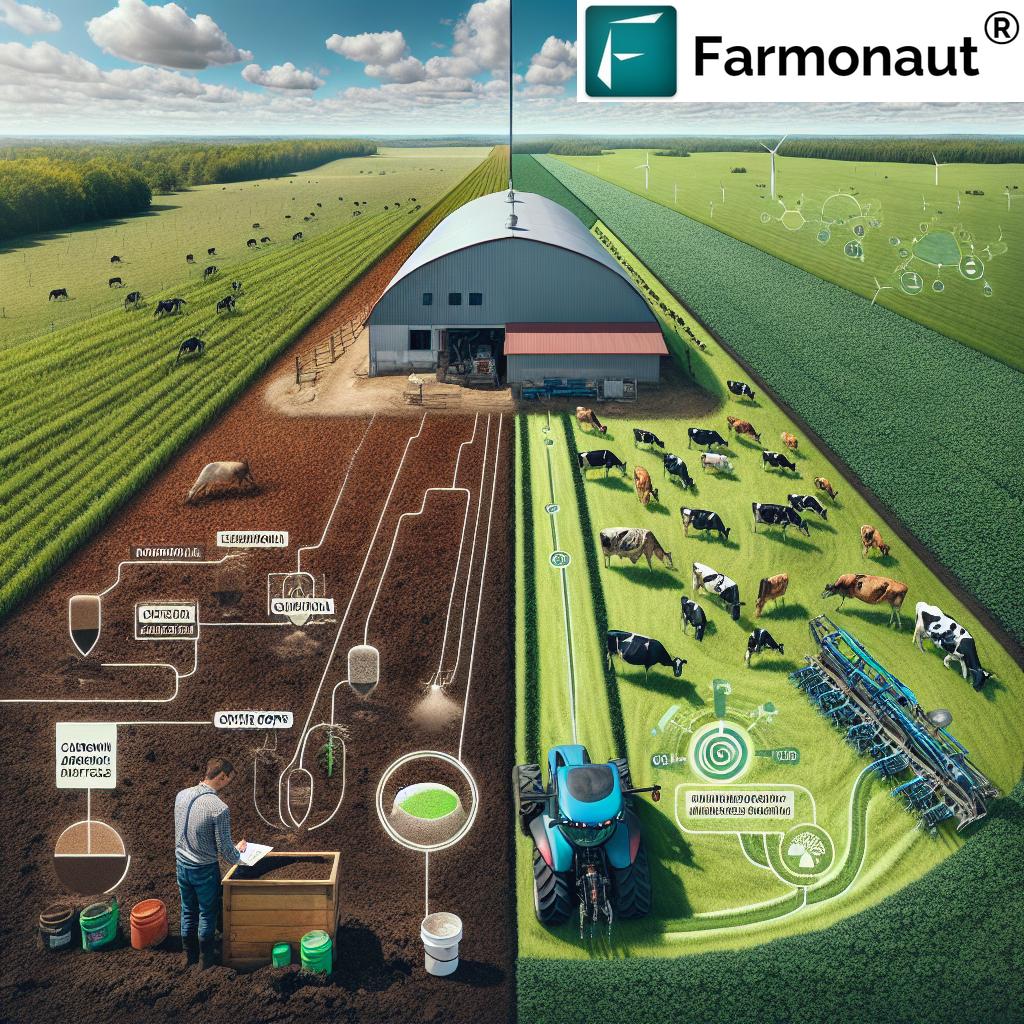Sustainable Dairy Farming in Canada: How Farmonaut Supports Net-Zero Emissions and Soil Health
“Canadian dairy farms have reduced their carbon footprint by 22% per liter of milk produced since 2011.”
In the ever-evolving landscape of Canadian agriculture, sustainable dairy farming has emerged as a beacon of innovation and environmental stewardship. As we navigate the challenges of climate change and resource conservation, the dairy industry in Canada is leading the charge towards a more sustainable future. In this comprehensive guide, we’ll explore how Canadian dairy farmers are embracing cutting-edge technologies and regenerative farming practices to achieve net-zero emissions, improve soil health, and preserve our precious ecosystems.

The Evolution of Sustainable Dairy Farming in Canada
Canadian dairy farmers have long been at the forefront of sustainable agriculture. Over the years, we’ve witnessed a remarkable transformation in the industry, driven by a commitment to environmental stewardship, animal welfare, and food safety. Today, sustainable dairy farming in Canada is characterized by:
- Adoption of regenerative farming practices
- Implementation of water conservation techniques
- Focus on biodiversity preservation
- Emphasis on soil health improvement
- Commitment to net-zero emissions agriculture
These initiatives are not just good for the environment; they’re essential for the long-term viability of the dairy industry and the health of our planet.
Regenerative Farming Practices in Canadian Dairy
Regenerative farming is at the heart of sustainable dairy farming in Canada. This approach goes beyond sustainability by actively improving the ecosystems in which farms operate. Here’s how Canadian dairy farmers are implementing regenerative practices:
- Cover Cropping: Planting diverse cover crops between dairy feed crop rotations to enhance soil structure and prevent erosion.
- Rotational Grazing: Implementing managed grazing systems that mimic natural herd movements, promoting pasture health and carbon sequestration.
- Minimal Tillage: Adopting no-till or minimal tillage practices to preserve soil structure and reduce carbon release.
- Composting: Utilizing manure and organic waste to create nutrient-rich compost, reducing the need for synthetic fertilizers.
These practices not only improve soil health but also contribute significantly to carbon reduction efforts in the dairy industry.
Water Conservation: A Priority for Canadian Dairy Farms
Water is a precious resource, and Canadian dairy farmers are taking innovative steps to conserve it:
- Precision Irrigation: Utilizing advanced irrigation systems that deliver water exactly where and when it’s needed.
- Rainwater Harvesting: Collecting and storing rainwater for use in farm operations.
- Water Recycling: Implementing systems to treat and reuse water from dairy operations.
- Drought-Resistant Crops: Selecting feed crops that require less water without compromising nutritional value for dairy cows.
These water conservation techniques not only reduce the environmental impact of dairy farming but also help farms become more resilient in the face of climate change.
Biodiversity Preservation in Canadian Dairy Farming
Preserving biodiversity is crucial for maintaining healthy ecosystems. Canadian dairy farmers are taking steps to protect and enhance biodiversity on their farms:
- Hedgerow Planting: Creating natural habitats for wildlife and beneficial insects.
- Native Plant Species: Incorporating native plants into pastures and field margins to support local ecosystems.
- Wetland Conservation: Protecting and restoring wetland areas on farm properties.
- Pollinator Programs: Establishing dedicated areas for pollinators, crucial for ecosystem health.
These efforts not only support local wildlife but also contribute to the overall health and productivity of dairy farms.
Soil Health: The Foundation of Sustainable Dairy Farming
Healthy soil is the cornerstone of sustainable agriculture. Canadian dairy farmers are implementing various techniques to improve and maintain soil health:
- Crop Rotation: Implementing diverse crop rotations to improve soil structure and nutrient content.
- Reduced Chemical Inputs: Minimizing the use of synthetic fertilizers and pesticides to promote soil microbial health.
- Soil Testing and Monitoring: Regular soil analysis to optimize nutrient management and prevent over-fertilization.
- Organic Matter Management: Incorporating organic matter into soils to enhance fertility and water retention.
By focusing on soil health, dairy farmers are not only improving their land but also increasing the nutritional quality of their dairy products.
“Farmonaut’s satellite-based crop monitoring system covers over 1 million acres of farmland in Canada, supporting sustainable agriculture.”
The Role of Technology in Sustainable Dairy Farming
Technology plays a crucial role in advancing sustainable dairy farming practices. One of the most significant innovations in this field is satellite-based crop monitoring, offered by companies like Farmonaut. This technology provides farmers with real-time data on crop health, soil moisture, and other critical factors, enabling more precise and sustainable farm management.
Farmonaut’s satellite-based crop monitoring system is particularly valuable for dairy farmers looking to optimize their feed production and pasture management. By providing accurate, up-to-date information on crop conditions, Farmonaut helps farmers make informed decisions about irrigation, fertilization, and harvesting, reducing waste and improving efficiency.
Key benefits of satellite-based crop monitoring for dairy farms include:
- Optimized resource use, reducing water and fertilizer consumption
- Early detection of crop stress or disease, allowing for timely interventions
- Improved pasture management, ensuring optimal grazing conditions for dairy cows
- Enhanced planning for feed production, reducing reliance on external inputs
Net-Zero Emissions: The Ultimate Goal for Canadian Dairy
The Canadian dairy industry is committed to achieving net-zero emissions, a goal that aligns with global efforts to combat climate change. This ambitious target requires a multi-faceted approach:
- Energy Efficiency: Implementing energy-efficient technologies in dairy operations, such as LED lighting and variable speed pumps.
- Renewable Energy: Investing in solar, wind, and biogas energy systems to power farm operations.
- Methane Reduction: Adopting feed additives and manure management practices to reduce methane emissions from dairy cows.
- Carbon Sequestration: Implementing practices that increase carbon storage in soils and vegetation on dairy farms.
Achieving net-zero emissions is a challenging but crucial goal for the dairy industry, requiring ongoing innovation and commitment.
Agricultural Plastic Recycling: A Step Towards Circular Economy
Agricultural plastic waste is a significant environmental concern. Canadian dairy farmers are taking proactive steps to address this issue through recycling initiatives:
- Bale Wrap Recycling: Participating in programs to collect and recycle plastic bale wrap used for feed storage.
- Silage Bag Recycling: Implementing systems to recycle large silage bags used for feed preservation.
- Milk Container Recycling: Ensuring proper recycling of milk containers and other dairy packaging materials.
- Upcycling Initiatives: Exploring innovative ways to repurpose agricultural plastics into new products.
These recycling efforts not only reduce waste but also contribute to the circular economy, aligning with broader sustainability goals.

Animal Health and Welfare in Sustainable Dairy Farming
Sustainable dairy farming goes hand in hand with exceptional animal care. Canadian dairy farmers are implementing various practices to ensure the health and well-being of their cows:
- Advanced Monitoring Systems: Using technology to track individual cow health and behavior.
- Comfortable Housing: Designing barns that prioritize cow comfort and natural behaviors.
- Nutritional Management: Implementing precision feeding to meet the nutritional needs of each cow.
- Preventative Health Care: Focusing on proactive health management to reduce the need for antibiotics.
By prioritizing animal welfare, dairy farmers not only improve the lives of their cows but also enhance the quality and sustainability of milk production.
The Impact of Sustainable Practices on Milk Quality and Safety
Sustainable farming practices have a direct positive impact on milk quality and safety. Here’s how:
- Improved Feed Quality: Sustainable crop management leads to higher quality feed, resulting in better milk composition.
- Reduced Chemical Use: Minimizing chemical inputs in farming reduces the risk of residues in milk.
- Enhanced Animal Health: Healthier cows produce higher quality milk with fewer health concerns.
- Advanced Testing: Implementing rigorous quality control measures to ensure milk safety.
These practices not only benefit consumers but also contribute to the overall sustainability and reputation of the Canadian dairy industry.
Farmonaut’s Contribution to Sustainable Dairy Farming
Farmonaut’s advanced satellite-based crop monitoring system is playing a crucial role in supporting sustainable dairy farming practices across Canada. By providing real-time data and insights, Farmonaut empowers dairy farmers to make informed decisions that optimize resource use and improve farm productivity.
Key features of Farmonaut’s system that benefit dairy farmers include:
- Crop Health Monitoring: Real-time tracking of feed crop health using multispectral satellite imagery.
- Soil Moisture Analysis: Accurate assessment of soil moisture levels to optimize irrigation.
- Weather Forecasting: Precise weather predictions to support farm management decisions.
- AI-Powered Insights: Advanced analytics to provide actionable recommendations for farm optimization.
By leveraging these tools, dairy farmers can significantly enhance their sustainability efforts while improving operational efficiency.
Explore Farmonaut’s API for advanced agricultural data integration
The Future of Sustainable Dairy Farming in Canada
As we look to the future, the Canadian dairy industry is poised for continued innovation in sustainability. Emerging trends and technologies that will shape the industry include:
- Precision Agriculture: Further integration of AI and IoT technologies for ultra-precise farm management.
- Carbon Markets: Participation in carbon credit systems to incentivize emissions reduction.
- Circular Economy Models: Developing closed-loop systems that minimize waste and maximize resource efficiency.
- Alternative Energy Sources: Expanding the use of renewable energy in dairy operations.
These advancements will further solidify Canada’s position as a leader in sustainable dairy production.
Sustainable Dairy Farming Practices and Their Impact
| Sustainable Practice | Environmental Benefit | Estimated Carbon Reduction (%) | Farmonaut’s Role |
|---|---|---|---|
| Regenerative Farming | Improves soil health, increases biodiversity | 10-20% | Monitors soil health indicators through satellite imagery |
| Agricultural Plastic Recycling | Reduces waste, promotes circular economy | 5-10% | Tracks land use changes and potential recycling areas |
| Water Conservation Techniques | Preserves water resources, reduces runoff | 15-25% | Provides soil moisture data for optimized irrigation |
| Precision Farming with Satellite Monitoring | Optimizes resource use, reduces waste | 20-30% | Offers real-time crop health and yield prediction data |
Conclusion: A Sustainable Future for Canadian Dairy
The journey towards sustainable dairy farming in Canada is well underway, with farmers, technology providers, and industry stakeholders working together to create a more environmentally friendly and efficient dairy sector. By embracing regenerative practices, leveraging advanced technologies like Farmonaut’s satellite monitoring system, and committing to net-zero emissions, Canadian dairy farms are setting a global standard for sustainable agriculture.
As consumers, we can support these efforts by choosing Canadian dairy products and appreciating the hard work and innovation that goes into every liter of milk produced. Together, we can ensure a sustainable, healthy, and prosperous future for Canadian dairy farming and our planet.
Access Farmonaut’s API Developer Documentation
FAQ Section
Q: What is sustainable dairy farming?
A: Sustainable dairy farming involves practices that maintain or improve environmental quality, enhance animal welfare, and ensure economic viability for farmers while producing high-quality dairy products.
Q: How are Canadian dairy farmers reducing their carbon footprint?
A: Canadian dairy farmers are reducing their carbon footprint through various methods, including implementing renewable energy systems, improving feed efficiency, adopting regenerative farming practices, and utilizing precision agriculture technologies.
Q: What role does technology play in sustainable dairy farming?
A: Technology, such as Farmonaut’s satellite-based crop monitoring system, plays a crucial role by providing real-time data on crop health, soil moisture, and weather patterns, enabling farmers to make informed decisions that optimize resource use and reduce environmental impact.
Q: How does sustainable dairy farming impact milk quality?
A: Sustainable practices often lead to improved milk quality by enhancing animal health, optimizing feed quality, and reducing the use of chemicals in farming operations.
Q: What is net-zero emissions agriculture, and how are dairy farms working towards it?
A: Net-zero emissions agriculture aims to balance the greenhouse gases produced by farming activities with an equivalent amount removed from the atmosphere. Dairy farms are working towards this goal through energy efficiency, renewable energy adoption, methane reduction strategies, and carbon sequestration practices.






